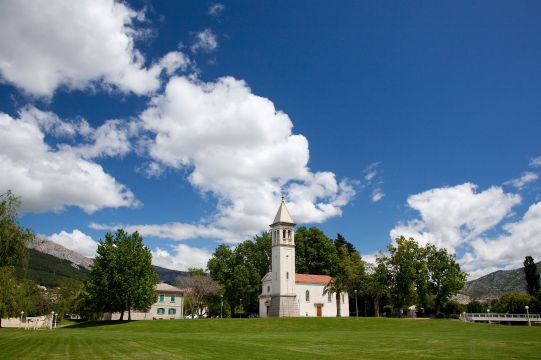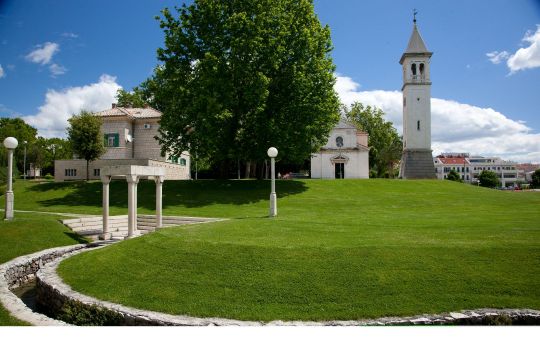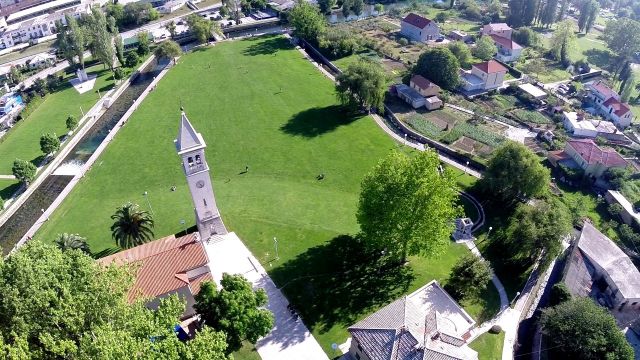In the very centre of Salona, on a river islet (Gospin otok – Our Lady’s Islet) in the delta of Salona’s river Salon, now known as the Jadro, next to the parish church of St. Mary, Our Lady of the Islet (Sv. Marija, Gospa od Otoka), there is an exceptionally valuable archaeological site, now totally covered with earth. The present parish church was built in 1880. To its south there is a grassy area where thousands of believers attended the mass on the occasion of the visit of Pope John Paul II, in 1998.
To the north of the present St. Mary’s Church, under the earth, there are remains of a church with a nave and two aisles dedicated to St. Stephen (Sv. Stjepan). It was built on top of Roman remains, which is a rule in Salona, on a river islet. It should be kept in mind here that the river flowed in a completely different in Roman times, through the town centre, this being evidenced by the remains of the so-called Šuplja crkva (Hollow Church), then the largest old-Christian basilica of Salona, now in the river bed, but not at the time of building the church.
The old-Christian church on Gospin otok and the Queen Helena’s sarcophagus with its famous inscription were found, as it often happens, co-incidentally. After the old church on the islet was destroyed in the fire of 1875, the new, present, church was built in its present location in 1880. When the foundations for the new bell tower were dug in 1898, remains of older walls were excavated. The finds attracted attention of the then director of the Split Archaeological Museum, rev. Frane Bulić, who found them worth excavating. Soon, in the church’s atrium, they found fragments of an inscription, one of them reading HEL. Bulić concluded they were fragments of the front side of a sarcophagus, all covered with an inscription. As the respected expert, he recalled the History of Salona by the Split chronicler, archdeacon Toma where it was stated that the honourable man Dimitrije, also known as Zvonimir, the King od the Croats, restituted to Sv. Dujam’s (St. Domnio’s) Church (i.e., to the Archbishopric of Split) the churches of St. Stephan and St. Mary with all their properties. These churches were built and donated by the Queen Helena, giving them to the Church of Split to hold them forever. Because of the adoration of some royal graves, they were temporarily given to some friars who celebrated masses in them. In St. Stephan Church’s atrium, there was buried the honourable man, King Krešimir, with many other kings and queens.
The detailed research carried out in 1972 next to and within the present church, as well as the above quoted text, cleared some doubts, and it may be well reasonably concluded that on the Islet there was one church, dedicated to St. Stephen, and not two, as it was believed. Namely, above the Roman remains, a three-aisled church was built in the 10th century, in the atrium in which they found the broken sarcophagus with the queen’s epitaph. The church certainly existed at the chronicler Toma’s time, since he described it in detail, confirming there were royal graves in the atrium. The church is also mentioned in later centuries documents, so it may be concluded that it must have fallen into ruins, neglected, and destroyed at the time of the wars against the Turks in the 16th and the 17th centuries.
The new inhabitants of Solin, colonised by the Venetian authorities after conquering Klis, did not reconstruct St. Stephen’s Church but, next to its ruins, built a new one at the beginning of the second half of the 17th century. The church was to be destroyed in a fire in 1875. According to L. Katić, it was built before 1670, since the first baptism in the church on Islet was recorded in the church books on the Mary’s Nativity Day of that year. St. Stephen’s Church is depicted in the watercolours by P. Zečević (1807-1876), according to new research made by A. Duplančić. We consider however, that the humble building, as depicted in Zečević’s watercolour, that it was a church similar in appearance and size to the many churches built throughout Dalmatia in the Baroque époque.









